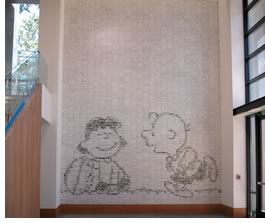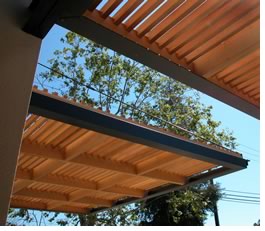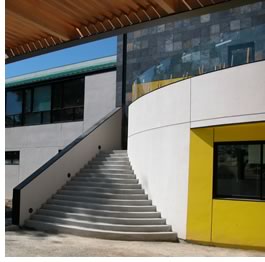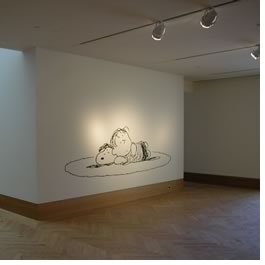
Cartoonist Charles M. Schulz

Associate Editor
Good Grief! It is a daunting endeavor to design a building to pay tribute to a cultural icon. It's even harder when the beloved figure, cartoonist and Peanuts comic strip creator Charles M. Schulz, is as self-effacing as his character Charlie Brown, the round-faced kid to whom he will be forever linked, personally and professionally.
But, as a longtime Peanuts fan, architect David Robinson, FAIA, enthusiastically embarked on translating into his museum design the philosophical and humanistic themes of Schulz's cartoons, and to convey the artist's sense of quiet humor and strong community that he portrayed through his philanthropy and his art.
 Robinson,
principal of C. David Robinson Architects, San Francisco, said he and
his team tried, most of all, to create a space where "Sparky's (a.k.a.
Charles Schulz) spirit would be happy and comfortable."
Robinson,
principal of C. David Robinson Architects, San Francisco, said he and
his team tried, most of all, to create a space where "Sparky's (a.k.a.
Charles Schulz) spirit would be happy and comfortable."
Sparky's spirit
Robinson's team worked with Schulz and his wife Jeannie on the initial
planning for the unique museum, starting two years before the June 2000
groundbreaking in Santa Rosa, Calif. . . . After Schulz's death, the architect,
with direction from Jeannie and the museum's board of directors, continued
to develop plans for the 27,000-square-foot museum and research center
slated to open later this month.
The architects, taking cues from Schulz's unassuming and understated personality, designed what Robinson describes as a large landscaped site, with a low-key, low-tech, and natural home. It incorporates a palette of rich stone and dark woods that reflect Schulz's Minnesota roots, such as slate, which is used on the exterior and as flooring in the great hall and entry, and cherry wood, used as paneling and woodwork. A large slanted copper roof will oxidize to the blue-green of a California seascape.

The unpretentious Santa Rosa facility is truly home to Sparky's spirit. It lives in the city where he and his wife made their home, and where he maintained his drawing studio. The site itself sits across the street from the Redwood Empire Ice Arena, which Schulz opened in 1969, and where he played pick-up games of ice hockey.
 Schulz
and his gang
Schulz
and his gang
The architects employ a "modest scale" to make visitors feel
as though they are inhabiting the world of the diminutive Peanuts
characters. They also aim to capture Schulz's métier with exterior
walls that are painted in graphic black-and-white panels accented with
the strong colors you find in the Sunday funnies. A large curved wall
draws visitors to the entrance, and the circular motif is repeated in
the interior ceilings. "Brightly colored exterior walls, floating
thought bubbles in the lobby ceiling and figures of Snoopy silhouetted
against the sky all contribute to a fun-loving celebration of Schulz's
art and life," the architects note.
The museum will, of course, feature Schulz's original artwork, which will be presented in permanent and temporary galleries. The first floor of the museum will house a replica of Schulz's studio. A wall of original Schulz art from the 1950s—from a former home in Colorado—will also be installed there. The museum's planners commissioned two works by Japanese artist Yoshiteru Otani, one wooden piece that details the evolution of Snoopy and another mural with 1,900 tiles with individually stamped comic strips. On the whole, they reveal the figure of Charlie Brown and Lucy typically poised together with a football.
 "Never
forgetting that this is an institution built on humor, we have done our
best to suggest the playful whimsy of his cartoon world," Robinson
said.
"Never
forgetting that this is an institution built on humor, we have done our
best to suggest the playful whimsy of his cartoon world," Robinson
said.
The museum provides a variety of exhibit, functional, and recreational spaces. The $8 million project features several large-scale art installations, accommodated through 10-foot ceilings. It also holds a 100-seat auditorium, great hall for ceremonial and programmatic functions, museum store, classroom and education space, outdoor gardens, sculptures and exhibits, and a 51' x 57' labyrinth in the shape of Snoopy's head.
Importantly, the museum also offers a research center with an archive, where scholars and the public can make appointments to study Schulz's artwork and maybe laugh a little, too.
 Blanket
appeal
Blanket
appeal
Museum officials are anticipating a large crowd from around the globe
at the site's opening August 17.
Robinson, who likens Schulz's drawing line to that of American writer and cartoonist James Thurber, said that part of the appeal of Schulz's work is its universality. For example, he noted that there is rarely a building exterior—save for Snoopy's doghouse—in any of Schulz's strips, which allows readers to place the child-like characters in their own context. He said it is just one example that deserves some study in the research center.
Indeed, Schulz touched a chord in us all, and one of the temporary shows will be a display of tributes to the artist from cartoonists worldwide.
Copyright 2002 The American Institute of Architects. All rights reserved.
![]()
|
Don't be a blockhead! Click here to learn more about the Charles M. Schulz Museum and Research Center's grand opening, which will be August 17. Click here to learn more about C. David Robinson Architects, San Francisco. The firm has provided design services to numerous cultural facilities in California, including the San Francisco Museum of Modern Art; the Yerba Buena Center for the Arts; Fresno Art Center; and the Ansel Adams Friends of Photography Gallery, San Francisco. |
|